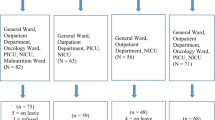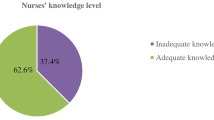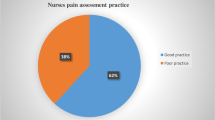Abstract
Background
American Nurses Association reflects, the role of the nurse in pain management encompasses the entire nursing process, assessment of pain, plans pharmacological and non-pharmacological pain management strategies, implements the plan, and evaluates the response of the patient to the interventions. Pediatric pain management has been left largely unaddressed due to factors like limited resources, inadequate training, as well as cultural diversity and language barriers which made sick and injured children not to receive basic pain care. The objective of this study was to assess the knowledge and factors associated with pain management for hospitalized children among nurses.
Design
Institution based cross-sectional study was employed from a total of 261 nurses in Public Hospitals of Mekelle City from March 15 to April 15, 2015. Systematic random sampling method was used to get the study subjects. Self-administered questionnaire was used to collect data. The collected data was cleared, categorized, and coded. The cleaned data was analyzed using Statistical Package for the Social Sciences, version 20 software with statistical significance p < .05 at 95% CI. Descriptive statistics was employed. Binary logistic regressions were used to see relationship between dependent and independent variables.
Results
Out of 251 participants more than half (58.6%) of nurses had adequate knowledge and had good practice 140 (55.8%). Those respondents who said yes sedation interfering with pain assessment were 2.7 more likely knowledgeable on pain management for hospitalized children than others. In addition to this those nurses who said they had a specific pain management protocol in their institution were 2.159 more likely knowledgeable than others.
Conclusions
Majority of nurses were knowledgeable on some of pharmacological and non-pharmacological pain managements. Most of the nurses had a good practice on children pain managements. Reading guide lines, specific protocols, knowledge, charting area for pain, sedation interfering with pain assessment and working in pediatric ward were some of the factors that were significantly associated with children’s pain management.
Similar content being viewed by others
Background
Pain is unpleasant emotional and sensory complain associated with actual or potential tissue damage as defined by International Association for the Study of pain [1]. Since the late 1980s, children’s pain has become recognized as an important clinical concern and main area of focus for different researchers [1]. In the contrary, pain management services are not easily available to children in the developing world, where there is difficulty to give standard care [2]. In 2009, it was estimated that more than 33 million Americans were living with serious pain that lasted 1 year or more [3]. Different hospitals have taken numerous steps to improve their pain management strategies and Joint Commission standards indicate in 2003 patients have a right to effective pain management and routine pain assessment for all patients [3].
According to the American Nurses Association (ANA), the role of nurses in pain management includes the entire nursing process, assessment of pain, plan of pharmacologic and non-pharmacologic pain management strategies, implementation and evaluation of the response of the patient to the interventions [1]. Non-pharmacologic approaches to treat pain in children include psychological, educational and parental support [4]. For children undergoing frequent painful procedures, cognitive-behavioral interventions that minimize anxiety and distress, can be quite effective [4]. Non steroidal anti-inflammatory drugs (NSAIDS) like aspirin are very effective for the management of mild-to moderate pain or in combination with opioids (e.g. codeine, pethidine) which are commonly given in health institutions in the study area)for more severe pain [4]. The advantages of good analgesia are particularly important for ill patients because of its physiologic and psychologic benefits [5]. Adequate pain management reduces anxiety of children and parents and increases compliance and collaboration, which can reduce some of the burden on medical staff and resources [6]. In light to this evidence, proficient pain management for ill patients is a significant factor in meeting their needs and maximizing the chance of recovery [7]. Inadequately treated acute pain has a negative impact on many systems of the body, harmful physical and psychologic consequences in all age group clients [5].
Eventhough increased effort has been used to improve pain management over the last decade, up to 81% admitted children complain moderate to severe levels of pain [8]. However, nurses administer only 23–43% of analgesics ordered [9]. Pediatric pain management has been left largely unaddressed due to factors like limited resources, inadequate training, as well as cultural diversity and language barriers which made sick and injured children not to receive basic pain care [10]. Nurses’ knowledge and attitudes can affect their ability to give effective pediatric pain management [11]. In addition to that personal values and beliefs of the health care providers about pain greatly affect the treatment of pain [11]. For instance, 55–90% nurses believe that children exaggerate their pain report [11]. Lack of knowledge about Opioid, negative attitudes toward prescribing Opioid, and inadequate pain-assessment skills, lack of communication skills combine to create major barriers to pain relief [12]. Therefore, the main objective of this study was to assess the knowledge and factors associated with pain management for hospitalized children among nurses working in public Hospitals in Mekelle City, North Ethiopia.
Methods
This institution based cross sectional study was conducted in Mekelle City; public hospitals from March 15 to April 15, 2015. All Nurses who had been working in all Public Hospitals of Mekelle City were the source population. The total sample size was 261 nurses which was calculated using single population proportion formula with the assumption of proportion of nurses who had sufficient knowledge on pain management (41%), with 5% margin of error and 95% confidence level of certainty. There are four public hospitals in Mekelle City, lottery method was used to select three public hospitals in the city. A list of all the four hospitals was prepared and it was drawn blindly to select the three hospitals. After proportional allocation to sample size to each hospital systematic random sampling method was used to select study participants with K value of 2 (meaning, every other nurse is selected). Simple random sampling had been employed to select the first study subjects. The data collection tool was English version structured questionnaire developed from different literatures because the authors cannot find standardized questionnaire specifically in children. The questionnaire had 3 parts: part one sociodemographic of respondents; part two Knowledge related questions and part 3 factors associated with pain management related questions. The questions were reviewed by experts and seniors. Three trained diploma nursing students and one degree nurse supervisor was recruited and participated throughout the data collection procedures. Before the actual data collection period, to ensure the validity and reliability of the questionnaire, it had been pre-tested on 5% of nurses working in 1 non-selected public hospital of the city.
The filled questionnaires were presented to the principal investigator every day and had been checked for its completeness. Responses in each question had been coded to make the data entry simpler. SPSS version 20 software was used for data analysis. Descriptive analysis, such as, frequency and measures of central tendency was computed as well as bivariate analysis had been used to assess the association between the dependent and independent variables. Then the assumptions of, interaction, multi co-linearity, and outliers where checked and considering the p < .05 cut off point as significant for all the independent variables, the model logistic regression was computed. Then the result had been presented using text, graphs, figures and tables. Ethical clearance secured from Mekelle University, College of health sciences, Institutional review board and official letter was obtained from the respective bodies. Information was given to all study participants about the purpose of the study, their right to participate or to terminate at any time if they want was assured and respondents were informed about the confidentiality of information obtained. Then, written informed concent was obtained from each participants before the interview.
Operational definition
Adequate knowledge: those who scored above the mean on knowledge items and.
Inadequate knowledge: those who scored below mean to knowledge items.
Results
Sociodemographic characteristics
Out of the expected 261 respondents in this study, 251 participated with response rate of 96.5%. More than half 147 (58.6%) of the participants were females with the mean age of 34 years (SD = ±9.899). About 53.8% were in age group of 20–30 years. Of all participants majority (93.6%) were registered staff nurses and 6.4% were head nurses. More than a quarter of the participants (38.2%) had 2–4 years of nursing experience but only 12.7% had work experience of more than 10 years. Out of the total participants, 87.6% were degree holders in their level of education and 239 (95.2%) were full-time workers. Eighty-five (33.9%) participants were from medical ward while 28.7% were from pediatric ward (Table 1).
Knowledge of nurses towards pain management
Nearly half 121 (48.2%) of the participants answered that nurses provide the most accurate rating whereas only 16 (6.4%) relatives scored the least to accurately rate pain intensity and manage pain. About 88.8% respondent knew that frequently assessing and documenting pain is important whereas 11.2% responded not important for patients who able to communicate. Majority of the participants knew the importance of pain management among; post-operative patients (91.2%), medical (81.7%), patients with trauma (90.4%). But more than half of participant (66.9%) did not know how to manage pain for patients with Glasgow Coma Scale <8 (Table 2). About 58.6% had adequate knowledge about pain management in children (Fig. 1).
Factors related to knowledge of nurses for pain management
Logistic regression was used to determine the set of variables which predicted knowledge of pain management. The variables that showed significant association in bivariate logistic regression were: experience in caring for hospitalized children, qualification, usual shift of rotation, lack of availability of pain assessment tool, patient inability to communicate, lack of protocols, experience on caring for hospitalized children, having pain management guidelines, specific protocol, reading guidelines in managing children’s pain, insufficient anesthesia, poor communication of pain assessment, poor documentation of pain assessment and management, sedation interfering, no designated area for charting pain, low priority of pain. Finally sedation interfering with pain assessment and specific protocol remained significant in the multivariate analysis. Those respondents who said yes sedation interfering with pain assessment were 2.7 more likely knowledgeable on pain management for hospitalized children than their counter parts [AOR 2.707 (1.4–5.232)]. In addition to this those nurses who said they had a specific pain management protocol in their institution were 2.159 more likely knowledgeable [AOR 2.159 (1.106–4.212)] (Table 3).
Discussion
A total of 251 nurses were participated in this study, out of these 58.60% nurses had adequate knowledge with some gaps that need consideration. This was almost similar with a study done in Nigeria in which 60% of nurses had knowledge and a study conducted in Bangladesh in which 66.79% nurses had adequate knowledge [13, 14]. On the other this was higher than a study done in Uganda Mulango hospital in which 41% nurses had adequate knowledge [15]. This variation might be because of time gap and different study subjects.
Majority of the participants knew that it is important to manage pain among; post operative patient (91.2%), medical (81.7%), trauma patients (90.4%), and Burn patient (89.6%). These results are reasonable with the fact that these patients need special care for their high pain intensity and most of the time better treatments are given in ICU’s jointly with pain management treatments. But more than half of participant did not know that managing pain for patients with Glasgow Coma Scale <8 is important; this could be due to the nurses misperception on unconsciousness believing unconscious children don’t feel pain since the patient don’t communicate besides being a child. Because of the fact that Pathophysiology of pain is complex and wide array, its management requires multimodal approach; pharmacotherapy (NSAIDs, adjuvant analgesics, opioid) and non pharmacologic ones [16].
Concerning the non-pharmacological management, 71.3% knew distraction of pain by music and relaxation is appropriate in managing children’s pain. In the contrary a study in Hong Kong showed that nurses have inadequate knowledge about both pharmacological and non-pharmacological interventions for pain [17]. This difference might be due to time gap, study area and study design difference.
Those respondents who said yes sedation interfering with pain assessment were more likely knowledgeable on pain management for hospitalized children than others, these showed their genuine response in the area of pain assessment for sedated patients. Fifty-one percent of respondents who have specific protocols in their institution are found to be two times more likely knowledgeable, which is very promising to the institution since the hospitals are public teaching and as well as referral hospitals.
Conclusion
The study tried to determine the knowledge and factors associated with pain management. Based on the findings the study the following was concluded:
-
Majority of nurses have adequate knowledge about the principles of pharmacological and non pharmacological pain managements. However, they lack knowledge on some key issues of opioid analgesics.
-
Pain managements of nurses is mostly constrained by; lack of guidelines and specific protocols, inadequate knowledge of the nurses, unavailability of documentation charts, not working in pediatric wards and sedation interfering with pain assessment. These all factors were pertinent for the management of pain in children.
Abbreviations
- AICU:
-
adult intensive care unit
- ANA:
-
American Nurses’ Association
- NSAID:
-
non steroidal anti inflammatory drugs
- PICU:
-
pediatric intensive care unit
- PRN:
-
pro re nata/as needed
- VAS:
-
visual analog scale
References
International Association of the Study of Pain. Sub-committee on taxonomy. Pain terms: a list with definitions and notes on usage. Pain. 1979;6:249–52.
Finley GA, Kristjánsdóttir Ó, Forgeron PA. Cultural influences on the assessment of children’s pain. Pain Res Manag. 2009;14(1):33–7.
Minnesota Boards of Nursing. Joint Statement on Pain Management. Minnesota Boards of Medical Practice, Nursing, and Pharmacy. 2009. www.nursingboard.state.mn.us
Ashley E, Given J. Pain management in critically ill. Chest J. 2009;135(4):1075.
Bower TC, Reuter JP. Analgesia, sedation and neuromuscular blockade in the trauma patient. In: McQuillam KA, Makic MBF, Whalen E, editors. Trauma nursing from resuscitation through rehabilitation. 4th ed. Philadelphia: Saunders Elsevier; 2009. p. 372–421.
Zempsky WT, Schechter NL. What’s new in the management of pain in children. Pediatr Rev. 2003;24(10):337–48.
Shannon K, Bucknall T. Pain management in critical care: what have we learnt from research. Intensive Crit Care Nurs. 2003;19(3):154–62.
Pölkki T, Pietilä AM, Vehviläinen-Julkunen K. Hospitalized children’s descriptions of their experiences with postsurgical pain relieving methods. Int J Nurs Stud. 2003;40(1):33–44.
Jacob E, Puntillo K. Pain in hospitalized children: pediatric nurses’ beliefs and practices. J Pediatr Nurs. 1999;14(6):379–91.
Albertyn RA, Rodea H, Millara AJ, Thomas B. Challenges associated with pediatric pain management in Sub Saharan Africa. Int J Surg. 2009;7(2):91–3.
Manworren R. Pediatric nurses’ knowledge and attitudes survey regarding pain. Pediatr Nurs. 2000;26(6):610–4.
Kassa, et al. Assessment of knowledge, attitude and practice and associated factors towards palliative care among nurses working in selected hospitals, Addis Ababa, Ethiopia. BMC Palliat Care. 2014;13:6.
Ojong Idang N, Ojong-Alasia Mary M, Nlumanze Faith F. Nurses’ assessment and management of pain among surgical patients in secondary health facility in Calabar Metropolis, Cross River State, Nigeria. Eur J Exp Biol. 2014;4(1):315–20.
Md. Sazzad Hossain, Wiroonpanich W, Orapiriyakul R. Nurses’ knowledge and attitudes, and pain management practice of post-operative children in Bangladesh. The 2nd International Conference on Humanities and Social Sciences April 10th, 2010.
Kizza I. Nurses’ knowledge and practices related to pain assessment in critically ill patients at Mulago Hospital, Uganda. November 2012. Melbourne: National Health and Medical Research Council; 2011.
Manterola C, Vial M, Moraga J, Astudillo P. Analgesia in patients with acute abdominal pain. Cochrane Database Syst Rev. 2011;(1):CD005660. doi:10.1002/14651858.CD005660.pub3.
Lui LYY, Soori WKW. The knowledge and attitudes regarding pain management among the medical nursing staff in Hong Kong. Hong Kong: University of Hong Kong; 2015.
Authors’ contributions
RM was the principal author; made substantial contributions in conception selecting design, data collection as well as analysis and interpretation of data. AF and WT were the advisors of the paper; participated in revising and commenting the paper. KG and SA participated in manuscript preparation and editing the paper. All authors read and approved the final manuscript.
Acknowledgements
My appreciation goes to Mekelle University College of health sciences and department of Nursing for giving me educative opportunity. Tigray Regional Health Bureau deserves appraisal for their permission. I want to extend my appreciation to: Tigray, Vocational and Education training institute for its promising offer and funding for my research. The public Hospitals, data collectors, participants and others also need appreciation for their genuine participation and support.
Competing interests
The authors declare that they have no competing interests.
Availability of supporting data
All the data is presented in the main manuscript. Raw data can be obtained through an e mail to the principal author.
Ethics
Clearance obtained from Mekelle University, College of health sciences, Institutional review board.
Funding
The authors have not received any funding or benefits from industry or elsewhere to conduct this study.
Author information
Authors and Affiliations
Corresponding author
Rights and permissions
Open Access This article is distributed under the terms of the Creative Commons Attribution 4.0 International License (http://creativecommons.org/licenses/by/4.0/), which permits unrestricted use, distribution, and reproduction in any medium, provided you give appropriate credit to the original author(s) and the source, provide a link to the Creative Commons license, and indicate if changes were made. The Creative Commons Public Domain Dedication waiver (http://creativecommons.org/publicdomain/zero/1.0/) applies to the data made available in this article, unless otherwise stated.
About this article
Cite this article
Miftah, R., Tilahun, W., Fantahun, A. et al. Knowledge and factors associated with pain management for hospitalized children among nurses working in public hospitals in Mekelle City, North Ethiopia: cross sectional study. BMC Res Notes 10, 122 (2017). https://doi.org/10.1186/s13104-017-2446-7
Received:
Accepted:
Published:
DOI: https://doi.org/10.1186/s13104-017-2446-7





